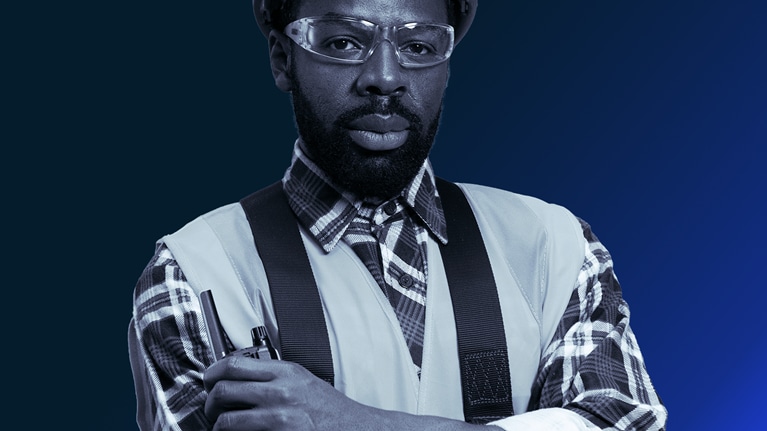Business leaders watching their organizations experience profound upheaval because of the COVID-19 crisis may find it difficult to understand what it all means until the dust settles.
Listen to this article
But the pandemic hasn’t afforded them, or any of us, that luxury. It has created profound and immediate changes to how societies operate and how individuals interact and work. We have all witnessed an at-scale shift to remote work, the dynamic reallocation of resources, and the acceleration of digitization and automation to meet changing individual and organizational needs.
Organizations have by and large met the challenges of this crisis moment. But as we move toward imagining a postpandemic era, a management system based on old rules—a hierarchy that solves for uniformity, bureaucracy, and control—will no longer be effective. Taking its place should be a model that is more flexible and responsive, built around four interrelated trends: more connection, unprecedented automation, lower transaction costs, and demographic shifts.
To usher in the organization of the future, chief human-resources officers (CHROs) and other leaders should do nothing less than reimagine the basic tenets of organization. Emerging models are creative, adaptable, and antifragile.1 Corporate purpose fuels bold business moves. “Labor” becomes “talent.” Hierarchies become networks of teams. Competitors become ecosystem collaborators. And companies become more human: inspiring, collaborative, and bent on creating an employee experience that is meaningful and enjoyable.
After the pandemic erupted last year, we spoke with 350 HR leaders about the role of uncertainty in their function. They told us that over the next two years they wanted to prioritize initiatives that strengthen their organization’s ability to drive change in leadership, culture, and employee experience.
How are they doing? In this article, we discuss ways that CHROs can continue to meet the moment by rethinking processes in three fundamental areas: identity, agility, and scalability.
How HR fits in the big picture
McKinsey has recently conducted research on how businesses can best organize for the future. The experimentation underway suggests that future-ready companies share three characteristics: they know what they are and what they stand for; they operate with a fixation on speed and simplicity; and they grow by scaling up their ability to learn and innovate.
HR can help propel this transformation by facilitating positive change in these three key areas, as well as with nine imperatives that radiate out from them (Exhibit 1).

Identity: HR can clarify the meaning of purpose, value, and culture
Companies that execute with purpose have greater odds of creating significant long-term value generation, which can lead to stronger financial performance, increased employee engagement, and higher customer trust.
Home in on the organization’s purpose
What is your company’s core reason for being, and where can you have a unique, positive impact on society? Now more than ever, you need good answers to those questions—purpose is not a choice but a necessity.
CHROs play a vital role in making sure the organization is living its purpose and values. HR can articulate and role-model desired individual mindsets and behaviors linked to purpose by identifying “moments that matter” in the company’s culture and translating purpose into a set of leadership and employee norms and behaviors.
For instance, commercial-vehicle manufacturer Scania holds an annual “Climate Day,” during which the company stops operations for one hour to hold sustainability training, in line with its purpose to “drive the shift toward a sustainable transport system.”2
HR can also ensure that clear changes are made to recruitment and capability-building processes by determining the characteristics of a “purpose driven” employee and embedding these attributes within recruitment, development, and succession planning.
HR can also incorporate purpose-driven metrics into compensation and performance decisions. Companies across industries have embarked on these metrics lately. For example, Seventh Generation, a maker of cleaning and personal-care products, recently built into its incentive system sustainability targets for the company’s entire workforce, in service of its goal of being a zero-waste company by 2025. Shell has plans to set short-term carbon-emissions targets and link executive compensation to performance against them.
Think deeply about talent
Organizations that can reallocate talent in step with their strategic plans are more than twice as likely to outperform their peers. To link talent to value, the best talent should be shifted into critical value-driving roles. That means moving away from a traditional approach, in which critical roles and talent are interchangeable and based on hierarchy.
Getting the best people into the most important roles requires a disciplined look at where the organization really creates value and how top talent contributes. Consider Tesla’s effort to create a culture of fast-moving innovation, or Apple’s obsessive focus on user experience. These cultural priorities are at the core of these companies’ value agendas. The roles needed to turn such priorities into value are often related to R&D and filled with talented, creative people.
To enable this shift, HR should manage talent rigorously by building an analytics capability to mine data to hire, develop, and retain the best employees. HR business partners, who articulate these staffing needs to the executive management team, should consider themselves internal service providers that ensure high returns on human-capital investments. For example, to engage business leaders in a regular review of talent, they can develop semiautomated data dashboards that track the most important metrics for critical roles.
Create the best employee experience possible
Companies know that a better employee experience means a better bottom line. Successful organizations work together with their people to create personalized, authentic, and motivating experiences that tap into purpose to strengthen individual, team, and company performance.
The HR team plays a crucial role in forming employee experience. Organizations in which HR facilitates a positive employee experience are 1.3 times more likely to report organizational outperformance, McKinsey research has shown. This has become even more important throughout the pandemic, as organizations work to build team morale and positive mindsets.
HR should facilitate and coordinate employee experience. Organizations can support this by helping HR evolve, strengthening the function’s capability so that it becomes the architect of the employee experience. Airbnb, for instance, rebranded the CHRO role as global head of employee experience. PayPal focused on HR’s capability and processes to create a better experience for employees, including coaching HR professionals on measuring and understanding that experience, and using technology more effectively.
Strengthen leadership and build capacity for change
Culture is the foundation on which exceptional financial performance is built. Companies with top-quartile cultures (as measured by McKinsey’s Organizational Health Index) post a return to shareholders 60 percent higher than median companies and 200 percent higher than those in the bottom quartile.
Culture change should be business-led, with clear and highly visible leadership from the top, and execution should be rigorous and consistent. Companies are more than five times more likely to have a successful transformation when leaders have role-modeled the behavior changes they were asking their employees to make.
To strengthen an organization’s identity, HR should ask the following questions:
- How can we develop an energizing sense of purpose that has a tangible impact on our strategic choices and ways of working?
- How can we identify key talent roles and focus them on creating value?
- How can we build a data-driven, systemic understanding of our organizational health?
Agility: HR’s role in flattening the organization
Organizational agility improves both company performance and employee satisfaction. HR can be instrumental in shifting an organization from a traditional hierarchy to a marketplace that provides talent and resources to a collection of empowered small teams, helping them to achieve their missions and acting as a common guiding star.
Adopt new organizational models
For instance, as a part of a multiyear agile transformation, a large European bank worked to establish an in-house agile academy led jointly by coaches and the HR function to drive capability building for the transformation.
To be successful, a transformation should touch every facet of an organization—people, process, strategy, structure, and technology. HR can help create an iterative approach by developing core elements of the people-management process, including new career paths for agile teams, revamped performance management, and capability building. It should lead by example as well, by shifting to agile “flow to work” pools in which individuals are staffed to prioritized tasks.
Create a flexible—and magnetic—workforce
Because many roles are becoming disaggregated and fluid, work will increasingly be defined in terms of skills. The accelerating pace of technological change is widening skill gaps, making them more common and more quick to develop. To survive and deliver on their strategic objectives, all organizations will need to reskill and upskill significant portions of their workforce over the next ten years.
According to a 2018 McKinsey survey, 66 percent of executives said that “addressing potential skills gaps related to automation/digitization” within their workforces was at least a “top ten priority.” HR should help prioritize these talent shifts.
In a more recent survey McKinsey conducted with global executives about the postpandemic workforce, more than a third of respondents said that their organizations were unprepared to address the skill gaps exacerbated by automation and digitization. The shift to digitization has accelerated during the pandemic: 85 percent of companies have picked up the pace of their digitization (including a 48 percent rise in the digitization of customer channels). In light of these trends and the need to shift skills, there is a clear business rationale behind workforce strategy and planning.
HR should be a strategic partner for the business in this regard, by ensuring that the right talent is in place to deliver on core company objectives. HR can also drive workforce planning by reviewing how disruptive trends affect employees, identifying future core capabilities, and assessing how supply and demand apply to future skills gaps.
Moving to a skills focus also requires innovative sourcing to meet specific work-activity needs (for example, the gig economy and automation), and changing which roles companies need to source with traditional full-time-equivalent positions and which can be done by temporary workers or contractors. In the survey with global executives, about 70 percent said that two years from now they expect to use more temporary workers and contractors than they did before the COVID-19 crisis.
During the pandemic, we’ve seen how organizations have come together to utilize talent with transferable skills. For instance, McKinsey has supported Talent Exchange, a platform that uses artificial intelligence to help workers displaced by the crisis.
Make better decisions—faster
Companies that make decisions at the right organizational level and that have fewer reporting layers are more likely to deliver consistently on quality, velocity, and performance outcomes and thus outperform their industry peers. The pandemic has trained the spotlight on the power of fast decision making, as many organizations have had to move dramatically more quickly than they had originally envisioned. For example, one retailer had a plan for curbside delivery that would take 18 months to roll out; once the COVID-19 crisis hit, the plan went operational in just two days.
HR can help with strong decision making by empowering employees to take risks in a culture that rewards them for doing so. McKinsey research revealed that employees who are empowered to make decisions and who receive sufficient coaching from leaders were three times more likely to say that their companies’ delegated decisions were both high quality and speedy.
Introduce next-generation performance management
Companies are experimenting with a wide variety of approaches to improve how they manage performance. According to a McKinsey Global Survey, half of respondents said that performance management had not had a positive effect on employee or organizational performance. Two-thirds reported the implementation of at least one meaningful modification to their performance-management systems.
We identified three practices—managers’ coaching, linking employee goals to business priorities, and differentiated compensation—that increase the chances that a performance-management system will positively affect employee performance. HR plays an important role in embedding these practices in performance management by supporting the goal-setting process, decoupling the compensation and development discussion, investing in manager’s capability building, and embedding technology and analytics to simplify the performance-management process.
To strengthen an organization’s agility, HR should ask the following questions:
- Can we enable more effective decision making by pushing decisions to the edges of the organization, creating psychological safety that empowers people, and building capabilities?
- How do we accelerate the shift to a more diverse and deeply motivated talent base, one that is supported through a human-centric culture that enables outperformance and superior experience?
- Which organizational areas or end-to-end value-creation streams would most benefit from a shift to new ways of working and organizing?
Scalability: How HR can drive value creation
The new normal of large, rapidly recurring skills gaps means that reskilling efforts must be transformational, not business as usual or piecemeal.
Lean into a learning culture by reskilling and upskilling
Effective reskilling and upskilling will require employees to embark on a blended-learning journey that includes traditional learning (training, digital courses, job aids) with nontraditional methods (enhanced peer coaching, learning networks, the mass personalization of change, “nudging” techniques).
For instance, Microsoft shifted from a “know it all” to a “learn it all” ethos, incorporating open learning days, informal social learning opportunities, learning data for internal career paths, and new platforms and products for its partner network.
Memo to HR: Look in the mirror
To drive and facilitate these workforce initiatives, HR must transform itself first. Talent is consistently ranked as a top three priority for CEOs, yet many lack confidence in HR’s ability to deliver.3 The HR function is often overburdened with transactional work and not well equipped to create value for the enterprise.
Yet people-first organizations look at business problems from the perspective of how talent creates value, and HR is well positioned to bring data-driven insights to talent decisions. HR can arm itself with data-driven insights and people analytics to support talent-driven transformation, and HR business partners can then consistently make talent decisions based on data.
Create a value-enhancing HR ecosystem
McKinsey analysis has shown that a preponderance of executives recognize how much external partnerships help companies differentiate themselves. Increased value can be created through ecosystems where partners share data, code, and skills. Success now requires “blurry boundaries” and mutually dependent relationships to share value. The need of the hour is for HR to collaborate on and leverage the landscape of HR tech solutions across the employee life cycle—from learning, talent acquisition, and performance management to workforce productivity—to build an effective HR ecosystem.
To strengthen an organization’s scalability, HR should ask the following questions:
- How can we set up platforms spanning multiple players in the ecosystem and enable new sources of value and employee experience through them?
- How can we become the best company to partner with in the ecosystem? How can we set ourselves up for fast partnering and make the ecosystem accessible?
- What are the critical skills that drive future value creation and how can we upskill our talent base accordingly?
Looking ahead: How transformation happens
As the organization of the future takes shape, HR will be the driving force for many initiatives: mapping talent to value; making the workforce more flexible; prioritizing strategic workforce planning, performance management, and reskilling; building an HR platform; and developing an HR tech ecosystem. For other initiatives, HR can help C-suite leaders push forward on establishing and radiating purpose, improving employee experience, driving leadership and culture, and simplifying the organization.
Given the magnitude of the task and the broad portfolio of value-creating HR initiatives, prioritization is critical.
In May of 2020, HR leaders attending a McKinsey virtual conference indicated that over the next two years, they wanted to prioritize initiatives that strengthen agility and identity. That included 27 percent who said that they would focus on responding with agility and 25 percent who prioritized driving leadership, culture, and employee experience. Next came mapping talent to value and establishing and radiating purpose, each at 13 percent (Exhibit 2).

At a second conference for HR leaders,4 about half of the assembled CHROs said that they were focusing on reimagining the fundamentals of the organization and rethinking the operating model and ways of working in the next normal.
We see organizations making this shift. Throughout the pandemic, HR has played a central role in how companies build organizational resilience and drive value. CHROs and their teams can continue on this path by connecting talent to business strategy and by implementing changes in the three core areas of identity, agility, and scalability, as well as the nine imperatives that flow from them.
A more flexible and responsive model will also help organizations meet coming demographic shifts and other workforce changes. Millennials are becoming the dominant group in the workforce (with Gen Z close behind), creating novel challenges for organizations to meet their needs. The prominence of the gig economy and alternate models of working will only grow, with 162 million workers in the European Union and the United States working independently—70 percent of them by choice. And the rapid spread of digital technology and automation is dramatically reshaping the global economy, with half the tasks people perform already automatable today.
These trends are not new, but they are approaching tipping points, placing organization at the top of the CEO agenda. CHROs can help leadership by transforming their own HR organizations: developing and reinforcing clear priorities; embracing new ways of working, including rapid iteration and testing with the business and seeking explicit feedback; and revamping the HR skill set by embracing agility and digital capabilities.
While clearly a trial by fire, the pandemic also provides an opportunity for HR to accelerate its shift from a service to a strategic function, helping to shape a more dynamic organization that is ready to meet the postcrisis future.


